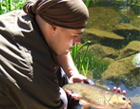
The Foragers Code
Wild food and foraging is becoming rather popular these days. In fact, it could even be considered ‘trendy’, due to the many cooking and survival shows that grace our TV schedules on an almost weekly basis. Trendy or not, learning how to forage safely is an essential bushcraft skill.
Before you begin foraging, it’s important to read over the subject intensively as well as attending some foraging courses with an expert guide to show you the ropes, not only to keep you alive and kicking, but also to pass on their knowledge of the natural environment and how you should respect it whilst foraging.
One of the most vital attributes any amateur forager should have is common sense! Over the years of teaching you’d be surprised at just how many silly and downright dangerous tales that I’ve heard, and in all honesty, I’m surprised some of the people telling these stories are still alive!
In addition to the rules that I’ve set out here, please always respect the environment when foraging – don’t over forage and please only forage for personal consumption or to feed your family and friends. All too many people are trying to forage on an almost commercial scale and this can lead to irreversible damage within our already strained natural environment – never put personal gain over the importance of nature.
K.I.S.S (Keep it Simple Stupid!)
It’s all too easy to get caught up trying to learn about everything. I’ve seen it many times before, and it often ends up causing confusion for those new to the subject – even seasoned foragers have to double check things from time to time. There is no shame in cross referencing with an identification guide. I’d recommend learning several common species first, and learning how to ID them with certainty. Most of the less well-known wild foods are generally not as tasty anyway!
Permission
Remember, most land is privately owned, and if you’re foraging on someone else’s land without permission (knowingly or not) you are breaking the law! Stick to public areas, or, better yet, contact the land owner – you’d be surprised how many times they will allow you to forage from their hedgerows – especially if you sweeten the deal with some sloe gin or preserves in the winter time.
Identification
There is no space for cutting corners here. Mix up your hogweed with hemlock and you’re dead, it’s that simple, but you’d be surprised how many people only fear fungi and seem to think that all plants are pretty much safe – not true! Always take a good plant identification guide with you and don’t be afraid to use it. If you’re still not sure of what you’re looking at – leave it alone. It’s also worth remembering that just because something is fine for most people to eat, it doesn’t mean that you won’t have a reaction to it – so only try a small amount of any new foods before turning them into a plentiful meal. For example, a friend of mine has a bad reaction to wild garlic or Ramsons (Allium ursinum) whilst the vast majority of us will be able to eat this plant with no ill-effects at all.
Location
It’s a good idea to avoid fruits grown alongside busy roads and motorways, and the same should apply to any agricultural land that is at risk of drift from pesticides. If foraging near water, or in water, check the water quality first – if it looks dirty or smells stagnant then would you really want to eat something that is absorbing it’s nutrients from it?
Almond Scent
Many fruits and flowers produce an almond-like scent and taste. This is due to the presence of hydrogen cyanide, a compound that is naturally occurring and perfectly safe in small quantities. Hydrogen cyanide is present in many fruits purchased in supermarkets, especially inside the stones (pips) of certain fruits. Whilst this isn’t really a concern with most wild foods found within the UK, if you can smell almonds from unknown species then it could be cause for alarm.
Respect the Environment
It’s all too easy to get carried away and taking more than you need. Try to avoid this – you may be in a large expanse of countryside, but the species of plant/fungi that you are foraging may be locally rare. Also, you should never remove the seeds of annuals, or trample through undisturbed areas where woodland plants grow.
Shellfish
I’ve decided to include shellfish here because they tend to be foraged rather than hunted, but I’m only covering the basics and I’d advise you do more research if trying your hand at collecting shellfish. Only ever forage shellfish from clean waters away from any human dwellings or activity. Ask local fisherman if they know of good ‘proven’ spots and only ever collect during the cold winter months.
Lastly
Foraging can be dangerous, but it needn’t be! Do your homework, look carefully and use your common sense and there is no reason why you shouldn’t try your hand at this fascinating subject. In fact, why not share your experiences, tips and tricks in the comments section below?


COMMENTS
LEAVE YOUR OWN COMMENT